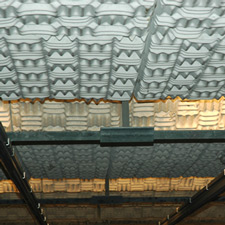Home | Glossary | Resources | Help | Contact Us | Course Map
Archival Notice
This is an archive page that is no longer being updated. It may contain outdated information and links may no longer function as originally intended.
Physical Plant
Forensic laboratories as well as the firearm examination areas within the laboratory and/or firing facility require special safety considerations, including
- evidence decontamination,
- lead abatement,
- ventilation,
- sound abatement.
Evidence Decontamination
Decontamination supplies, per laboratory protocol, include the following:
- Disinfectant solution for elimination of biohazards
- Cotton swabs, detergent, and a sonic cleaner for removal of blood and other tissue
Lead Abatement
Firing and bullet recovery facilities where lead can be accumulated require specialized prevention measures per laboratory protocol and may include the following:
- Frequent removal of lead buildup by qualified contractors
- Decontamination of lead on walls, ceilings, and floors of firing areas
- Removal of accumulated unburned and partially burned gunpowder from the floor of firing areas
- Provision for containment of the migration of lead and other heavy metals (e.g., tacky mats)
- Hand-washing equipment and supplies
Ventilation
Due to the health issues associated with lead, other heavy metals, and chemicals, provisions should be made to monitor and prevent ventilation hazards, per laboratory protocol, and may include
- exhaust ventilation of all firing spaces per standards established by the Occupational Safety and Health Administration (OSHA) and the National Institute for Occupational Safety and Health (NIOSH),
- annual airflow testing,
- appropriate air flow rates for all laboratory hoods.
Sound Abatement
The interiors of firing spaces, such as ranges and bullet recovery spaces, should be soundproofed to minimize noise levels and vibration. This is a particular concern in physical plants in which firing spaces are in close proximity to other examination spaces and/or delicate instrumentation (e.g., scanning electron microscopes, instrumental chemistry laboratory spaces).
Emergency Response Preparation
Advance preparation is necessary in the event of an inadvertent shooting incident and for other serious nonfirearm injuries. Procedures should be in place to maximize the ability to respond to an emergency situation.
Response Planning
The development of an emergency accident response plan (per laboratory protocol) is prudent for the laboratory setting. The plan should include a medical evacuation procedure that may contain the following elements:
- Posting of procedures for rapid access to laboratory spaces by emergency medical personnel
- Internal and external telephone contact numbers for emergency medical assistance
- Management telephone contact numbers
Emergency Response Training
Training (per laboratory protocol) should be provided for
- emergency response plan for accidental shootings,
- first aid for typical gunshot wounds,
- cardiopulmonary resuscitation (CPR),
- use of chemical spill kits.
Equipment
Emergency equipment may include
- first aid kits (including gunshot wound treatment),
- eye wash stations,
- chemical spill kits.
Selected Bibliography
The Selected Bibliography is a list of the writings that have been used in the assemblage of the training program and is not a complete record of all the works and sources consulted. It is a compilation of the substance and range of readings and extensive experience of the subject matter experts.
- 29 CFR 1910. Subpart L. Fire Protection.
- 29 CFR 1910.1030. Bloodborne Pathogens.
- 29 CFR 1910.1450. Occupational Exposure to Hazardous Chemicals in Laboratories.
- Ball, P., and D. Mikko. 1992. Protective optics. AFTE J 24 (1): 80-81.
- Centers for Disease Control and Prevention, National Institute for Occupational Safety and Health. http://www.cdc.gov/niosh/
- Dutton, G. 1997. Firearms safety in the laboratory. AFTE J 29 (1): 37-41.
- Geibel, J. May June 1992. Ammunition can be hazardous to your health (in more than the obvious way). Police and Security News p11.
- Martinez, A.M. August 1993. Lead poisoning. FBI Law Enforcement Bulletin p1-4.
- National Rifle Association, Gun Safety Rules. http://www.nrahq.org/education/guide.asp
- Silverwater, H, A. Koffman, and A. Zamir. 2001. Cross-infection of infectious diseases as applied to forensic firearms examinations and the means to prevent it. AFTE J 33 (3): 227-232.
- U.S. Department of Labor, Occupational Safety & Health Administration. http://www.osha.gov/
Additional Online Courses
- What Every First Responding Officer Should Know About DNA Evidence
- Collecting DNA Evidence at Property Crime Scenes
- DNA – A Prosecutor’s Practice Notebook
- Crime Scene and DNA Basics
- Laboratory Safety Programs
- DNA Amplification
- Population Genetics and Statistics
- Non-STR DNA Markers: SNPs, Y-STRs, LCN and mtDNA
- Firearms Examiner Training
- Forensic DNA Education for Law Enforcement Decisionmakers
- What Every Investigator and Evidence Technician Should Know About DNA Evidence
- Principles of Forensic DNA for Officers of the Court
- Law 101: Legal Guide for the Forensic Expert
- Laboratory Orientation and Testing of Body Fluids and Tissues
- DNA Extraction and Quantitation
- STR Data Analysis and Interpretation
- Communication Skills, Report Writing, and Courtroom Testimony
- Español for Law Enforcement
- Amplified DNA Product Separation for Forensic Analysts



